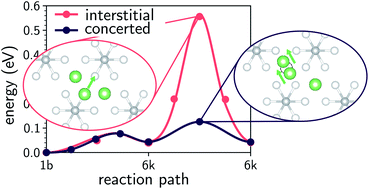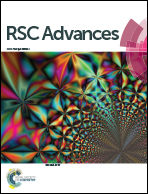Fast diffusion mechanism in Li4P2S6via a concerted process of interstitial Li ions†
Abstract
The synthesis of Li superionic conductor Li7P3S11 may be accompanied by the formation of a detrimental Li4P2S6 phase due to a high mixing sensitivity of precursor materials. This phase exhibits a poor ionic conductivity whose origins are not fully understood. Recently Dietrich et al. investigated the energetics of Li ion migration in Li4P2S6 with nudged elastic band (NEB) calculations. The observed large migration barrier of 0.51 eV for purely interstitial diffusion leads to an interpretation of the low ionic conductivity by kinetic limitations. Based on ab initio molecular dynamics simulations (AIMD) we propose a new and energetically much more favorable diffusion path available to interstitial Li ion charge carriers that has not been considered so far. It consists of a concerted process in which a second lithium atom is pushed out from its equilibrium lattice position by the diffusing lithium ion. A detailed analysis with NEB calculations shows that the energy barrier for this concerted diffusion is only 0.08 eV, i.e. an order of magnitude lower than the previously reported value for purely interstitial diffusion. Therefore, the observed low ionic conductivity of Li4P2S6 is likely not originating from kinetic limitations due to high diffusion barriers but rather from thermodynamic reasons associated with a low concentration of free charge carriers. We therefore expect that increasing the charge carrier concentration by doping is a viable design route to optimize the ionic conductivity of this material.



 Please wait while we load your content...
Please wait while we load your content...